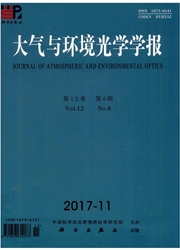

 中文摘要:
中文摘要:
利用卫星遥感地面空气质量是近年来随着空间遥感手段的进步而发展起来的一项新技术,如何利用卫星遥感的大气气溶胶光学厚度产品来定量评估地面空气质量是个难题。利用高分辨率的大气气溶胶光学厚度产品,经过垂直分布的订正和湿度影响的订正,分别得到地面气溶胶消光系数和地面“干”气溶胶消光系数。通过与地面PM10质量浓度的相关分析表明,地面气溶胶消光系数具有比大气气溶胶光学厚度更高的相关系数,而经过湿度订正的“干”气溶胶消光系数具有比前两者更高的相关系数。利用华北地区“干”气溶胶消光系数的分布评估了2008年夏季气溶胶变化情况,与往年同期相比,地面气溶胶消光季节平均下降约17%-20%,而华北平原其他城市和地区则没有显著变化,说明北京地区气溶胶浓度的下降与局地减排有直接关系。
 英文摘要:
英文摘要:
Remote sensing the surface air quality from space is a new technology following the development of the space-based observations. How to use the column atmospheric aerosol optical depth (AOD) products to quantitatively estimate surface air quality is a difficult question. The surface extinction coefficients (SEC) and the dry aerosol extinction coefficients (SECdry) are derived from high spatial resolution aerosol optical depth products with a vertical distribution correction and a moisture effect correction. It is found that the SEC has a higher correlation with surface PM10 mass concentration than the AOD, and the SEedry has the highest correlation among the three variables with PM10 measurements. The products of SECdry are used to estimate the air quality change in summer of 2008 in Beijing. Comparing with the seasonal averaged data in 2005-2007, the surface aerosol extinction in summer of 2008 decreased by 17-20%. In the other cities and regions of the North China Plain, there is no significant change on the surface aerosol distributions. It is concluded that the decrease of aerosol loading in Beijing is related to the local emission reduction directly.
 同期刊论文项目
同期刊论文项目
 同项目期刊论文
同项目期刊论文
 Analysis on the impact of aerosol optical depth on surface solar radiation in the Shanghai megacity,
Analysis on the impact of aerosol optical depth on surface solar radiation in the Shanghai megacity, 期刊信息
期刊信息
